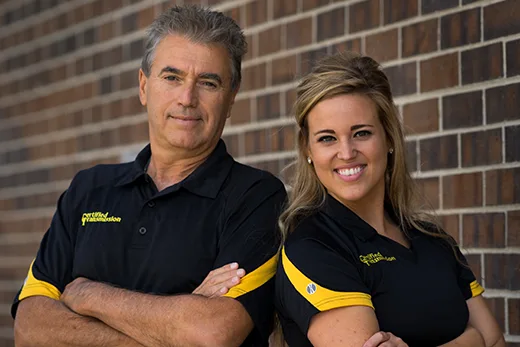Should I Flush Or Service My Transmission?
A regular question asked of the automotive repair technicians on staff at Certified Transmission is when should I flush my transmission? As a leading auto repair shop serving the Omaha area, Certified Transmission usually tells our customers that in most situations and for most vehicles a transmission service, involving dropping the transmission pan and changing the transmission fluid and filter, is recommended every 30,000 to 40,000 miles — and NOT a transmission flush.
And although Certified Transmission normally recommends a transmission service over a transmission flush, there are some situations when a transmission flush is required. For example, some transmissions do not have a filter that can be serviced. When having any type of transmission problem it is advised to have the vehicle's transmission inspected by an automotive repair specialist to help prevent or minimize any damage to the transmission.
Listed below are some of the more common transmission problems that indicate a vehicle should be brought to Certified Transmission for an external diagnostic inspection and complimentary test drive by a one of our professional transmission repair specialists.
Gear SlippingCertified Transmission tells our customers that just as a contaminated transmission may result in a loss of hydraulic power, not having enough transmission fluid may result in the same situation. For a car or truck to remain in the proper gear, a transmission is required to develop enough pressure. In the situation where a transmission has contaminants (clutch or metal debris for example), these contaminants can interfere with the transmission fluid flowing as intended to assist with the pressure required for proper performance.
When the transmission fluid level in a vehicle is low, it usually indicates that there is a leak and the vehicle should be brought into Certified Transmission for an inspection before any additional damage might occur. Additionally, the discovery of contaminates in the transmission fluid may indicate a bigger problem that can result in larger problems than what a flush or service may provide. In either situation it is best to schedule an appointment and let a professional automotive repair specialists address the gear slipping problem.
Transmission Grinding or Strange NoisesA situation that can often result in symptoms that are similar to low levels of transmission fluid is when a transmission is contaminated with grease, dirt, and sludge. Certified Transmission tells our customers that when driving around the roads of the greater Omaha area that if they notice a grinding or other strange noise from the transmission the vehicle should be stopped and the level of the transmission fluid should be checked with the engine still running. The color of the transmission fluid should be a bright red and not a brown or black color resulting from sludge or grime (it should be noted that some transmission fluid from European auto manufacturers has a similar color to new motor oil, i.e. golden brown).
Most importantly Certified Transmission recommends that if there is a grinding or other strange noise coming from your vehicle's transmission, your best option is to have the transmission inspected by a qualified transmission specialist, as having a transmission flush may not be the best option for the problem and may in fact worsen the situation resulting in more damage or expensive repairs. If you live in the greater Omaha area and are having a problem with transmission grinding or noise, Certified Transmission invites you to use our online appointment form to schedule an external diagnostic inspection and complimentary test drive by a one of our professional transmission repair specialists!
Gear Shifting ProblemsCertified Transmission tells our customers that regardless of whether they drive a vehicle with an automatic or manual transmission, the transmission fluid should flow effortlessly throughout the transmission. When excessive sludge or dirt is present, there may be a sluggish response in the transmission, causing the vehicle to change gears too late or too quickly when driving. In addition to the vehicle responding sluggishly, in vehicle's with manual transmissions the gears may even be difficult to or not shift at all.
As with the other transmission problems our customers in the greater Omaha area may experience with their transmissions, it is best to schedule an appointment and let an automotive repair specialist inspect the transmission to help minimize any additional problem with the transmission that may result from a gear shifting problem.
Vehicle SurgeThe explainable surging of a vehicle may indicate that the transmission is polluted with an abundance of contaminants or dirt and a flush is needed. A vehicle may have the tendency to jump or surge forward or fall backwards for no apparent reason if the transmission is dirty and not permitting adequate transmission fluid to flow. This is normally the result of the inconsistent flow of clean transmission fluid required to ensure proper operation of gears and other moving parts in the bell housing of a transmission.
Vehicle Movement DelayWhen a vehicle stalls for a couple of seconds after having been put into gear or even before moving it may be another indication that the transmission fluid is contaminated. In this situation and when no other problems are present flushing the transmission may benefit the vehicle.
Certified Transmission stresses to our customers in the greater Omaha area whom may be experiencing any of these transmission problems to have the vehicle inspected to see if the dirty transmission in the vehicle has not already resulted in potentially and more costly problems. If you are having problems with your transmission Certified Transmission suggests you use our online appointment form to schedule an inspection or transmission flush today!


